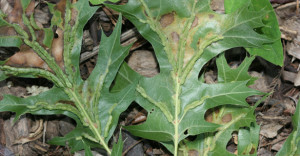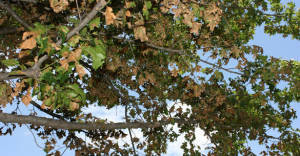Last week I got called to look at a tree that supposedly was turning brown from a tiny gall-making fly called Macrodiplosis quercusoruca, or vein pocket gall fly. I was skeptical that the leaf tissue death (necrosis) I saw on a small sample was caused by the insect. I have seen leaves disfigured and trees thinned by vein pocket gall, but had never seen a tree so heavily infested that the canopy was turned brown.
When I saw the tree I was convinced. Most of the leaves in the lower canopy were browning and damage from the fly seemed to go up into the upper reaches of the tree.
Galls are visible, cancer-like growths on plant parts. Their exact causes are not fully understood, but are thought to be the result of factors in the saliva of the insects or mites that feed or lay eggs on the plant. These saliva factors (or even just the mechanical injuries caused by the insects) appear to result in abnormal overproduction of normal plant growth hormones. These plant hormones, in turn, result in these plant growths we call galls.

Vein pocket galls on the underside of southern red oak leaves, Quercus schumardii. Note the beginning of leaf browning (necrosis) in some of these leaves.
The vein pocket gall fly lays its eggs on the underside of emerging oak leaves in the spring. As the larva hatches and begins to feed, cells in and along the veins begin to go into hyper-drive and form dense, crinkly ridges along the veins.
Like all galls, growth takes place when the leave or stems are actively growing. Once a leaf is fully formed, no further gall growth usually takes place, and no new galls are formed.
If you see these or other galls on your oak trees, there is really nothing that can be done about them. Once a gall is formed, even systemic insecticides are ineffective to kill the insect. In most cases, fortunately, galls are not considered damaging to trees, and by the time galls are noticed they generally don’t get any worse.
I don’t know what the fate of this oak tree will be next year, but I’m hoping it will be much less affected than it was this summer.
Control of galls is possible, but difficult, with insecticides. The insecticide must be applied at the time of adult egg-laying in the spring, or in the case of systemic insecticides, prior to egg-laying so that newly hatched larvae encounter the insecticide. In any case, there is little research on the impacts of either pesticides on galls or the impacts of galls on trees. I am consoled by the fact that galls and trees have had a long association, and tree death by gall must be very rare–or else more would be known about these unusual, intriguing insects.
For more information about gall-making insects, see Extension publication E-397.
